Many gym-goers want a strong, muscular back. However, traditional barbell exercises can sometimes feel intimidating or strain the lower back.
Then, a one-arm dumbbell row is a great exercise option.
This is a simple yet effective exercise that will help you build a bigger and stronger back and improve your posture.
Furthermore, if you have only one dumbbell and some space on the floor, you can easily add it to your home workout routine.
In this blog, we’ll dive into the details.
- What is One Arm Dumbbell Row
- Muscles Worked
- Benefits
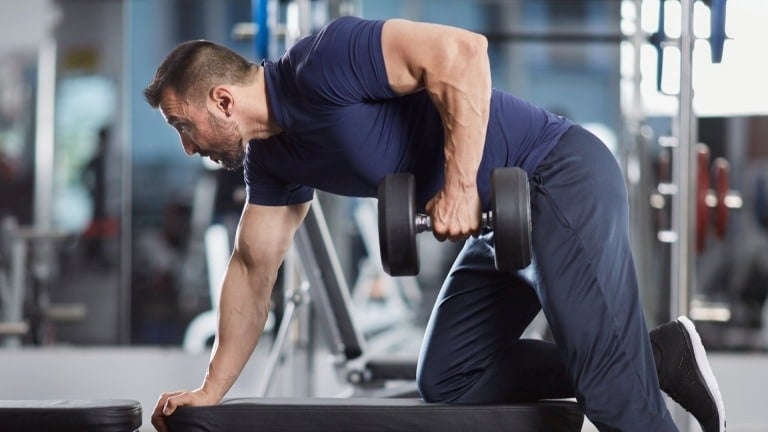
- What Is One Arm Dumbbell Row
- Muscle Worked During One Arm Dumbbell Row
- How To Single-Arm Dumbbell Row
- 2. One Arm Dumbbell Row With Rack Support
- How To Do It
- 3. Standing One Arm Dumbbell Row
- How To Do It
- 4. One Arm Incline Bench Reverse Grip Dumbbell Row
- How To Do It
- Tips and Techniques For Doing One-Arm Dumbbell Row
- One Arm Dumbbell Row Alternative
- FAQs
- How many sets and reps of one-arm dumbbell rows should I do?
- What weight should I use for one-arm dumbbell rows?
- How often should I do one-arm dumbbell rows?
- Can one-arm dumbbell rows be done at home without a gym?
- Takeaways
What Is One Arm Dumbbell Row
The one-arm dumbbell row is an excellent exercise for building the lat muscles. It’s an excellent alternative to barbell rows.
It is a compound exercise that primarily targets the back muscles, including the lats, rhomboids, and trapezius.
I’ll admit that I neglected this workout in favor of push-ups and barbell rows. When I started doing heavy one-arm dumbbell rows often, my back became bigger.
This helps to work on each side independently, thereby providing better muscle isolation and a longer range of motion. And greater hypertrophy.
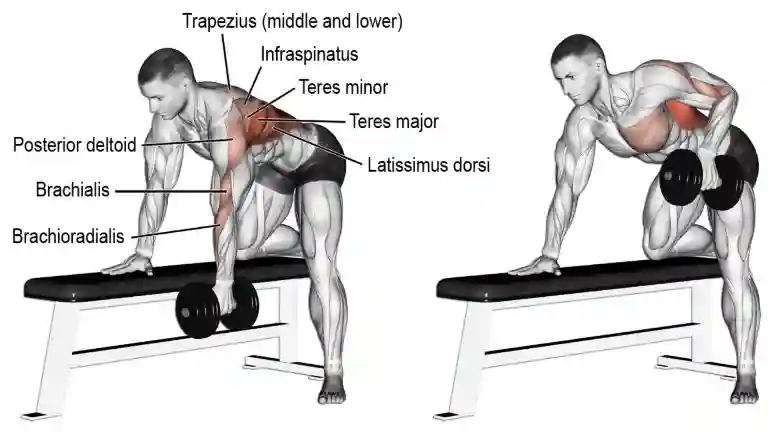
Muscle Worked During One Arm Dumbbell Row
The one-arm dumbbell row is a compound exercise that targets multiple muscle groups, including:
- The primary muscle works the Latissimus dorsi, Trapezius, rhomboids, rear deltoid.
- During the row, the secondary muscles worked are the biceps and forearms.
- Additionally, they work the core muscles, the serratus anterior, legs and glutes which help to keep the body stable during the exercise.
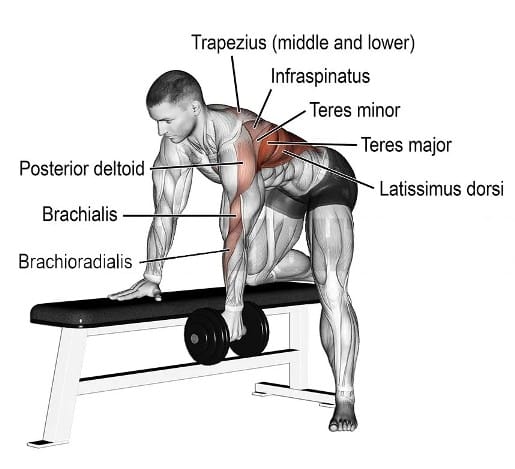
How To Single-Arm Dumbbell Row
- Start by putting your knee and the hand of your supporting side flat on a bench.
- For stability, your opposite leg should be firmly planted on the ground, slightly wider than hip-width.
- Hinge slightly forward from your hips so that your torso is roughly parallel to the floor.
- Keep your spine straight and just above parallel to the floor.
- With your free hand, pick up a dumbbell from the floor with a neutral grip (palm facing inwards)
- Let the dumbbell hang straight down with your arm extended.
- Focus on squeezing your shoulder blade back and pulling your elbow towards your abs, keeping your elbow close to your body.
- At the top of the row, briefly pause and squeeze your back muscles.
- With controlled motion, slowly lower the dumbbell back to the starting position.
- Repeat for all reps on one side before switching.
- Do 8–12 Reps on each side and 3–4 sets.
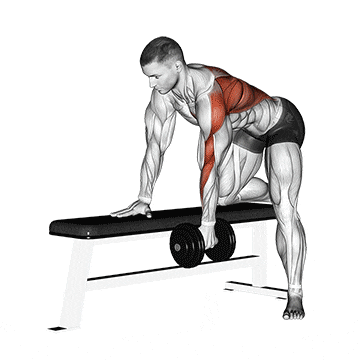
2. One Arm Dumbbell Row With Rack Support
Traditional one-arm rows can significantly strain the lower back, especially with heavier weights. However, using a rack allows us to keep our body more upright, which reduces back pressure and also helps us lift heavier weights.
The unilateral nature of the exercise stimulated the side core muscles (external oblique).
One more SECRET: it also allows some cheating reps.
This exercise variation is ideal for beginners or those with difficulty balancing on a bench or stable surface.
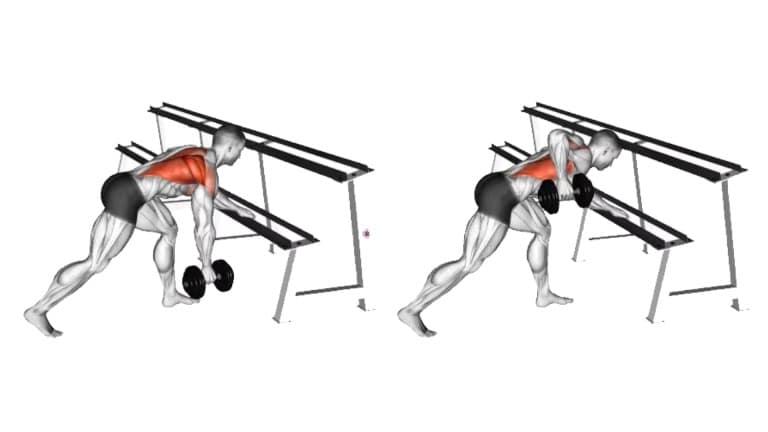
How To Do It
- Stand facing a weight rack with a dumbbell in your right hand and your feet shoulder-width apart.
- Lean forward and place your left hand on the weight rack.
- Keep your back straight and parallel to the ground.
- Keep your right arm extended down towards the ground.
- Exhale, pull the weight towards your chest and squeeze your shoulder blades together.
- Inhale and slowly lower the weight back down towards the ground.
- Complete the desired number of repetitions on one side before switching to the other side.
3. Standing One Arm Dumbbell Row
The standing one-arm dumbbell row is a good addition to any dumbbell back workout.
It is an advanced variation of a one-arm row, during which your core muscles work hard to keep your body stable and prevent excessive twisting or arching.
Along with increasing my back size, it also improves my core activation and grip strength.
One more BENEFIT:
You can perform it anywhere – even for home workouts where a bench or rack might not be available.
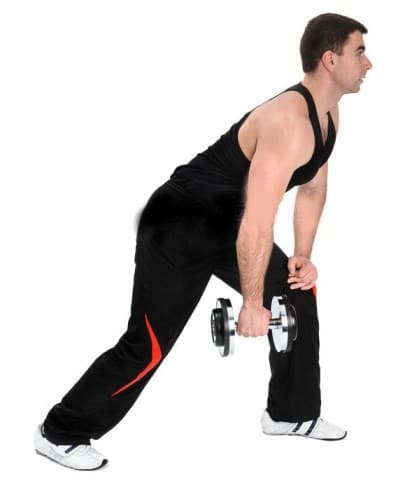
How To Do It
- Take one step back into a lunge position. Lean slightly forward, and rest your free hand on your front thigh.
- Keep your back straight and your core tight.
- Keep your arm extended down towards the ground.
- Pull the dumbbell towards your chest by driving your elbow to the ceiling.
- Slowly lower the dumbbell toward the floor until you have a full extension at the elbow.
- Do 8–10 reps.
- Switch arms and repeat the same number of repetitions.
4. One Arm Incline Bench Reverse Grip Dumbbell Row
The incline bench is more stable than a straight-arm row. It helps you isolate your back and arm muscles.
The reverse grip and incline position gave me some pretty amazing results.
When I do it at the end of each rep, my lats stretch really well. As I row up, I can feel my lats contracting intensely.
If you want to build a thicker, wider back, try it. You won’t be disappointed with the results.
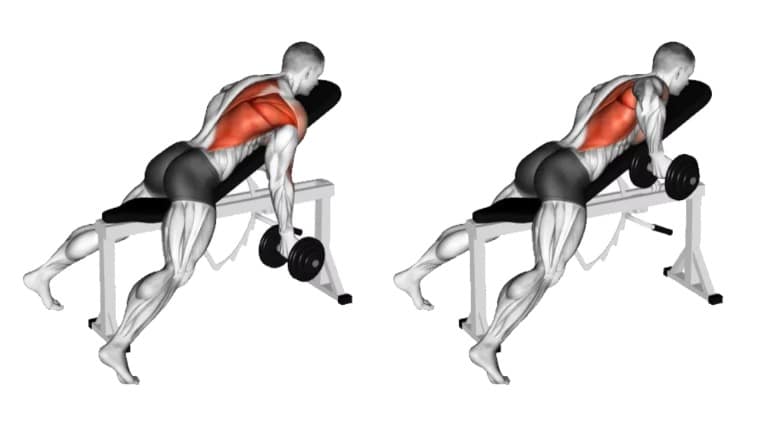
How To Do It
- Place a dumbbell on the floor next to the bench.
- Adjust the incline bench to a comfortable angle.
- Position yourself on the incline bench with your chest and stomach resting against the bench and your feet flat on the floor.
- Reach down and pick up the dumbbell with your right hand using a reverse grip.
- Pull the dumbbell up towards your torso.
- Lower the dumbbell back to its original position.
Tips and Techniques For Doing One-Arm Dumbbell Row
Performing one-arm dumbbell rows with incorrect form can lead to injury and reduced effectiveness of the exercise.
Here are some common mistakes you should avoid when performing one-arm dumbbell rows.
- If you use too much weight, the exercise will not work either. This is because you need to use momentum to lift the weight. Choose a weight that allows you to do the exercise correctly.
- Avoid arching or rounding your back, as this could cause strain on your spine. Keep your back straight and parallel to the ground.
- Focus on squeezing your shoulder blades together to lift the weight instead of using your arm to lift it.
- Avoid allowing your elbow to flare out to the side can strain your shoulder joint. Keep your elbow close to your body throughout the movement.
- Pull the dumbbell straight up towards your lower chest/abdomen.
- Activate your core as if anticipating a punch. This helps protect your lower back and improves stability.
- Don’t just move the weight—visualize your back muscles doing the work! This focus will yield better results.
One Arm Dumbbell Row Alternative
It is possible to perform several alternative exercises if you cannot access dumbbells or want to change your routine.
FAQs
How many sets and reps of one-arm dumbbell rows should I do?
A good starting point is to perform 3–4 sets of 8–12 reps per arm, using a challenging weight that allows for proper form.
However, it’s important to gradually increase the weight and reps over time to continue seeing progress and avoiding plateaus.
What weight should I use for one-arm dumbbell rows?
Pick the weight that allows you to perform the exercise with proper form and control for 8–12 reps.
If the weight is too light, increase it. If the weight is too heavy, decrease it until you can perform the exercise correctly.
How often should I do one-arm dumbbell rows?
Aim to perform one-arm dumbbell rows 1–2 times weekly, with at least 2 days of rest between workouts.
However, this can vary based on factors such as recovery time, training intensity, and other exercises in your routine.
Can one-arm dumbbell rows be done at home without a gym?
Yes, one-arm dumbbell rows can be done at home without a gym. You only need a dumbbell and a sturdy surface, such as a bench, chair, or table, to support your body.
It is possible to substitute a dumbbell with various household objects, such as a water jug or backpack filled with heavy items.
Takeaways
It is a great exercise to improve your back, shoulder, and arm strength.
You can also add variety to your workout routine by doing variations of the one-arm dumbbell row.
However, with consistent practice and dedication, the one-arm dumbbell row can help you build a stronger and healthier upper body.
References
- Mannarino P, Matta T, Lima J, Simão R, Freitas de Salles B. Single-joint exercise results in higher hypertrophy of elbow flexors than multijoint exercise. J Strength Cond Res. 2021;35(10):2677-2681.
- Valdes O, Ramirez C, Perez F, Garcia‐Vicencio S, Nosaka K, Penailillo L. Contralateral effects of eccentric resistance training on immobilized arm. Scand J Med Sci Sports. 2021;31(1):76-90. doi:10.1111/sms.13821
- Saeterbakken A, Andersen V, Brudeseth A, Lund H, Fimland MS. The Effect of Performing Bi- and Unilateral Row Exercises on Core Muscle Activation. Int J Sports Med. 2015 Nov;36(11):900-5. doi: 10.1055/s-0034-1398646. Epub 2015 Jul 2. PMID: 26134664.

Manish is a NASM-certified fitness and nutrition coach with over 10 years of experience in weight lifting and fat loss fitness coaching. He specializes in gym-based training and has a lot of knowledge about exercise, lifting technique, biomechanics, and more.
Through “Fit Life Regime,” he generously shares the insights he’s gained over a decade in the field. His goal is to equip others with the knowledge to start their own fitness journey.
